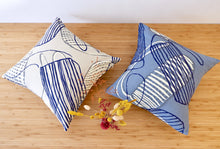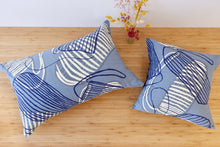Linda Gurawana's 'Kun-madj (Dilly Bags / Collecting Bags)' Cushion - Blue, 40x40cm
IDAIA x Babbarra
Regular price
€69.00
Sale
Art cushion cover 40 x 40 cm.
Removable with flap closure .
Fine art screen print on blue linen fabric, hand printed with eco-friendly inks by the female artists of the Bàbbarra Women's Center in the Aboriginal community of Maningrida in Arnhem Land.
Plain navy blue cotton fabric on the back.
Hand sewn in a Parisian workshop.
Machine wash cold possible.
Meaning of the fabric design:
Kun-madj is the Kuninjku Aboriginal term for large traditional woven collection baskets, known as dillybags or collection bags. They are often made from the Burney creeper (Malaisia scandens), a strong, flexible plant that grows on the ground among scrub formed after the monsoon in Arnhem Land. Baskets are used to collect a variety of fairly heavy foods, such as fish caught in conical traps or a good crop of yams.
Beyond their practicality, collection bags have an important symbolic meaning for the inhabitants of Arnhem Land. In their culture, “dilly bags” are totemic objects and they are associated with particular sites in the landscape.
Learn more about the collection
Complete with matching cushion insert
***
Cushion 'Kun-madj (Dilly Bags / Collection bags)' by Linda Gurawana
Art cushion 40 x 40 cm.
Removable envelope cover.
Fabric: Hand-screenprinted on blue linen fabric, with ecological inks, by the women artists of the Bàbbarra Women's Center in the Aboriginal community of Maningrida in Arnhem Land.
Plain navy blue cotton fabric on the back.
Hand sewn in a Parisian workshop.
Cold machine wash possible.
Cushion interior: recycled silicone polyester fibres, made in France. Can be machine washed at 30°.
Explanations for the design:
Kun-madj is the Kuninjku term for large woven collecting baskets, known as dillybags. They are often made from the burney vine (Malaysia scandens), a strong, pliable plant that grows along the ground and into the canopy of monsoon vine thickets. The baskets are used to collect a variety of heavy foods, such as fish caught in conical fish traps or a good harvest of yams.
As well as being of practical use, dillybags are of cultural significance to Arnhem Land people. Dillybags are totemic objects and they are associated with particular sites in the landscape.




